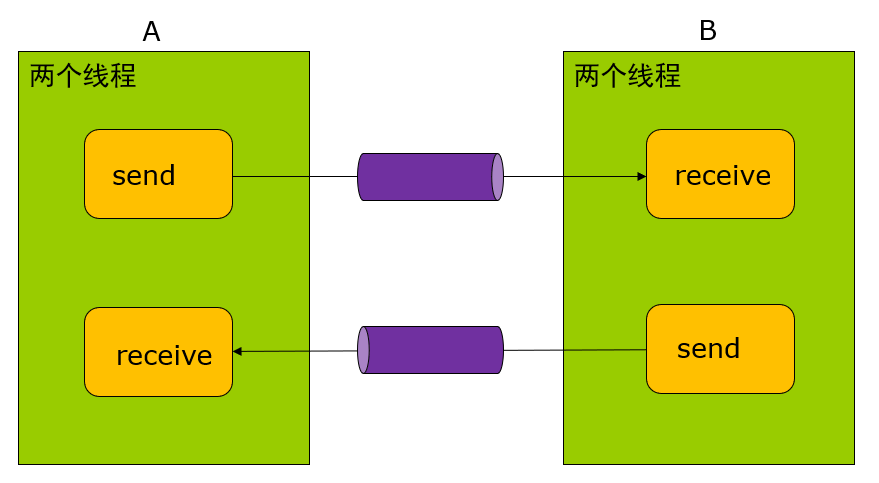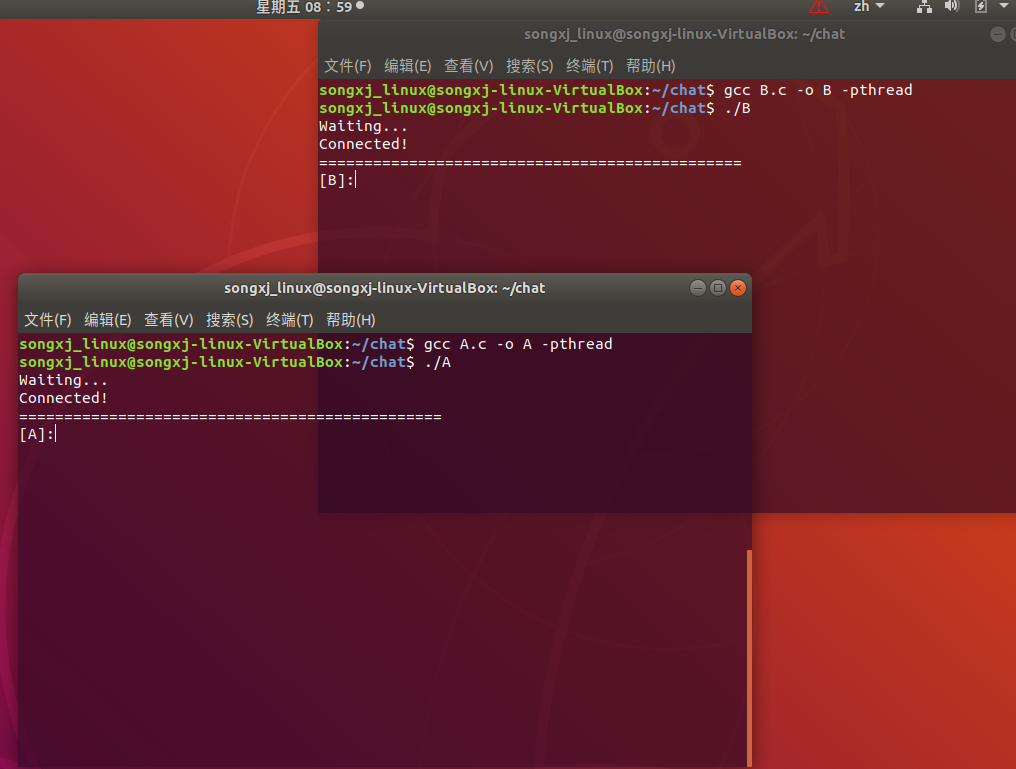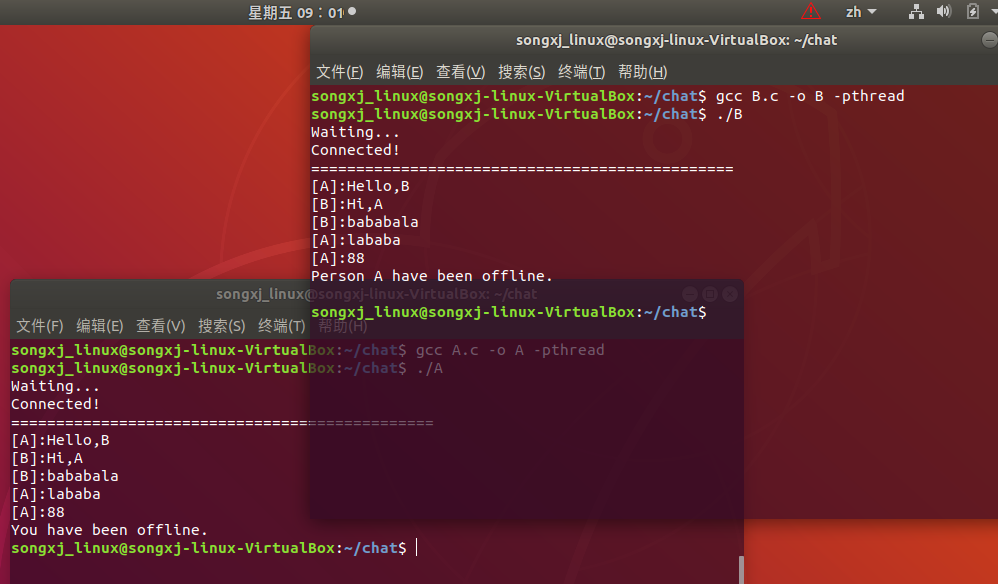这个实验会建立一个全双工系统(Full-Duplex),实现两个管道同时收发消息。在程序中会涉及到3个文件,2个管道,2个进程,4个线程。线程之间的拓扑图如下:

【完整代码附在文章最后】
创建连通管道
首先创建fifo_create.c文件来事先创建2个管道,分别为A发送B接收、A接收B发送。使用mkfifo()语句创建管道,分别标识为“A2B”、“B2A”。
访问权限为0644,第一位0不算,从左至右三个数字分别代表rw- r-- r--对应转化为的二进制110 100 100。十进制第1个数字代表文件所有者的权限,十进制第2个数字代表同组用户的权限,十进制第3个数字代表其他用户的权限。
之后验证mkfifo()的返回值,验证管道是否创建成功。如果创建成功,当前目录下回多出来“A2B”、“B2A”两个文件。
#include <stdio.h>
#include <sys/types.h>
#include <sys/stat.h>
int main(){
int A2B = mkfifo("A2B", 0644);
int B2A = mkfifo("B2A", 0644);
if (A2B == -1)
printf("Falled to create the FIFO of A2B!n");
if (B2A == -1)
printf("Falled to create the FIFO of B2A!n");
return 0;
}
创建2个进程4个线程
连接标记符
创建A.c和B.c两个文件,在两个文件中均创建send和receive两个线程。因为两个文件类似,这里以A.c为例,B.c同理。
在A.c中首先定义一个全局变量,用来标记两个管道是否连接,如果均连接成功,则flag=1,有任意一个管道断开则flag=0 。
//全局变量,标记是否连接,两个管道中有一个断开,则flag变为0
int flag = 1;
发送消息
通过send函数实现发送消息。在管道连通之前,即在open语句等待管道连通。这里open语句使用只写的方式进行打开,如果管道连接成功,程序继续向下运行。
定义一个循环进行消息的多次发送,使用fgets()语句从指定的标准输入流stdin中读取一行,并把它存储在buf所指向的字符串内,多余的长度使用�填充,而且fgets()语句包含换行符,所以在之后的receive函数中打印的时候不需要再添加换行符。
之后使用write语句将储存在buf中的全部字符串写入到刚才打开的A2B管道中。然后进行判断,如果刚才输入的是“88”则将标识符flag变成0,并打印下线提示,break出循环。如果输入的不是“88”,则在命令行打印[A]:,等待下一次输入。
最后关闭管道,退出线程。
//A给B发送消息
void* send() {
char buf[1024];
printf("Waiting...n");
int fd = open("A2B", O_WRONLY);
printf("Connected!n===============================================n");
if (fd == -1)
printf("Open fifo error!n");
printf("[A]:");
while (flag == 1){
fgets(buf, 1023, stdin);
write(fd, buf, 1023);
if (buf[0] == '8' && buf[0] == '8') {
flag = 0;
printf("You have been offline.n");
fflush(stdout);
break;
}
else if (flag == 1)
printf("[A]:");
}
close(fd);
pthread_exit(NULL); //退出线程
}
接收消息
通过receive函数实现接收消息的功能。在管道连通之前,即open语句等待管道连通。这里open语句使用只读的方式进行打开,如果管道连接成功,程序继续向下运行。因为在本实验中两个通道一定是同时连接的,在send函数中已经打印连接成功的提示,所以在receive中就没有重复打印。
定义一个循环进行消息的多次接收,使用read语句将管道中的字符串全部储存在buf中,之后在末尾加上一个�,表示字符串的结束。
然后进行判断,如果刚才接收到的是“88”则将标识符flag变成0,打印对方的最后一句话,同时打印对方已经下线的提示,break出循环。如果输入的不是“88”,则在命令行打印对方输入的内容后继续打印[A]:,等待下一次输入。
在打印接收到的对方消息时需要先在前面加上4个退格符,删除之前输入的[A]:这四个字符。另外要使用fflush(stdout);语句强制刷新标准输出缓冲区。
最后关闭管道,退出线程。
//A接收B发来的消息
void* receive() {
char buf[1024];
int fd = open("B2A", O_RDONLY);
if (fd == -1)
printf("Open fifo error!n");
while (flag == 1){
read(fd, buf, 1023);
//如果对方发“88”则断开连接,退出进程
if (buf[0] == '8' && buf[0] == '8') {
flag = 0;
memset(buf + 1023, '�', 1);
printf("bbbb[B]:%s", buf);
printf("Person B have been offline.n");
fflush(stdout); //强制刷新输出缓冲区
break;
}
else if(flag == 1){
memset(buf + 1023, '�', 1);
printf("bbbb[B]:%s", buf);//删除之前输入的[X]:这四个字符
printf("[A]:");
fflush(stdout); //强制刷新输出缓冲区
}
}
close(fd);
pthread_exit(NULL); //退出线程
}
双线程
在主函数中建立两个线程,并分别调用send和receive两个函数,并等待它们退出。
int main(){
pthread_t tid1, tid2; //线程ID
pthread_attr_t attr; //线程属性
pthread_attr_init(&attr); //设置默认线程属性
//执行两个线程分别进行收发
pthread_create(&tid1, &attr, send, NULL);
pthread_create(&tid2, &attr, receive, NULL);
//等待两个线程
pthread_join(tid1, NULL);
pthread_join(tid2, NULL);
return 0;
}
程序运行过程截图
-
等待连接

-
管道连接成功

-
进行全工聊天

-
聊天结束

总结
本次实验结合了多线程和管道连接的知识,实现了一个简单的单机聊天功能。在本次实验中有以下几个需要注意的地方:
fgets() 的特点:
gets()和fgets()都可以读取空格。gets()读取一行,不能设定读取容量,这一行有多少便读取多少,有可能会发生内存溢出。然而fgets()有三个参数,它是从 stream 流中读取 size 个字符存储到字符指针变量 s 所指向的内存空间。它的返回值是一个指针,指向字符串中第一个字符的地址。- 在本实验中
fgets()函数的读取大小均为1023,基本上满足了普通聊天的需要。fgets()函数的size参数如果小于字符串的长度,那么字符串将会被截取;如果size大于字符串的长度则多余的部分系统会自动用�填充。 fgets()函数会读取换行符,所以在receive接收后,打印时不需要再添加换行符。
fflush()强制刷新缓冲区:
在本实验中使用fflush()和stdout、stdin结合,可以将标准输入输出流中的数据强制刷新在命令行中。特别是在打印完接收的数据后,再次打印[A]:等待输入的字符串时,如果不进行强制刷新,这个字符串不会立刻显示在命令行中,而是跟随下一次的输入或输出结果同时显示。
“b”退格:
因为每次打印完聊天消息后,都需要继续打印[A]: 等待输入,而如果未进行输入而是接收了对方的消息,那么[A]:这个字符串就多余了,需要使用4个b删除。
实验的不足之处:
- 本实验在判断字符串是否为“88”时,使用的方法比较笨,同时比较两个字符完成的,其实可以使用
strcmp函数直接对两个字符串进行比较。 - 本实验的最后还有一个小bug,就是在
A输入“88”之后,两个程序不能立刻退出,而是需要在B上输入一个回车后才能退出,B对A发送消息情况同样。这个bug我试了很多方法都不能很好的解决,希望路过的大佬提供建议。
fifo_create.c
#include <stdio.h>
#include <sys/types.h>
#include <sys/stat.h>
int main(){
int A2B = mkfifo("A2B", 0644);
int B2A = mkfifo("B2A", 0644);
if (A2B == -1)
printf("Falled to create the FIFO of A2B!n");
if (B2A == -1)
printf("Falled to create the FIFO of B2A!n");
return 0;
}
A.c
#include <stdio.h>
#include <sys/types.h>
#include <sys/stat.h>
#include <fcntl.h>
#include <unistd.h>
#include <string.h>
#include <pthread.h>
//全局变量,标记是否连接,两个管道中有一个断开,则flag变为0
int flag = 1;
//A给B发送消息
void* send() {
char buf[1024];
printf("Waiting...n");
int fd = open("A2B", O_WRONLY);
printf("Connected!n===============================================n");
if (fd == -1)
printf("Open fifo error!n");
printf("[A]:");
while (flag == 1){
fgets(buf, 1023, stdin);
write(fd, buf, 1023);
if (buf[0] == '8' && buf[0] == '8') {
flag = 0;
printf("You have been offline.n");
fflush(stdout);
break;
}
else if (flag == 1)
printf("[A]:");
}
close(fd);
pthread_exit(NULL); //退出线程
}
//A接收B发来的消息
void* receive() {
char buf[1024];
int fd = open("B2A", O_RDONLY);
if (fd == -1)
printf("Open fifo error!n");
while (flag == 1){
read(fd, buf, 1023);
//如果对方发“88”则断开连接,退出进程
if (buf[0] == '8' && buf[0] == '8') {
flag = 0;
memset(buf + 1023, '�', 1);
printf("bbbb[B]:%s", buf);
printf("Person B have been offline.n");
fflush(stdout); //强制刷新输出缓冲区
break;
}
else if(flag == 1){
memset(buf + 1023, '�', 1);
printf("bbbb[B]:%s", buf);//删除之前输入的[X]:这四个字符
printf("[A]:");
fflush(stdout); //强制刷新输出缓冲区
}
}
close(fd);
pthread_exit(NULL); //退出线程
}
int main(){
pthread_t tid1, tid2; //线程ID
pthread_attr_t attr; //线程属性
pthread_attr_init(&attr); //设置默认线程属性
//执行两个线程分别进行收发
pthread_create(&tid1, &attr, send, NULL);
pthread_create(&tid2, &attr, receive, NULL);
//等待两个线程
pthread_join(tid1, NULL);
pthread_join(tid2, NULL);
return 0;
}
B.c
#include <stdio.h>
#include <sys/types.h>
#include <sys/stat.h>
#include <fcntl.h>
#include <unistd.h>
#include <string.h>
#include <pthread.h>
int flag = 1;
//B给A发送消息
void* send() {
char buf[1024];
printf("Waiting...n");
int fd = open("B2A", O_WRONLY);
printf("Connected!n===============================================n");
if (fd == -1)
printf("Open fifo error!n");
printf("[B]:");
while (flag == 1){
fgets(buf, 1023, stdin);
write(fd, buf, 1023);
if (buf[0] == '8' && buf[0] == '8') {
flag = 0;
printf("You have been offline.n");
fflush(stdout);
break;
}
else if (flag == 1)
printf("[B]:");
}
close(fd);
pthread_exit(NULL); //退出线程
}
//B接收A发来的消息
void* receive() {
char buf[1024];
int fd = open("A2B", O_RDONLY);
if (fd == -1)
printf("Open fifo error!n");
while (flag == 1) {
read(fd, buf, 1023);
if (buf[0] == '8' && buf[0] == '8') {
flag = 0;
memset(buf + 1023, '�', 1);
printf("bbbb[A]:%s", buf);
printf("Person A have been offline.n");
fflush(stdout);
break;
}
else if (flag == 1) {
memset(buf + 1023, '�', 1);
printf("bbbb[A]:%s", buf);
printf("[B]:");
fflush(stdout);
}
}
close(fd);
pthread_exit(NULL); //退出线程
}
int main(){
pthread_t tid1, tid2; //线程ID
pthread_attr_t attr; //线程属性
pthread_attr_init(&attr); //设置默认线程属性
//执行两个线程
pthread_create(&tid1, &attr, send, NULL);
pthread_create(&tid2, &attr, receive, NULL);
//等待两个线程
pthread_join(tid1, NULL);
pthread_join(tid2, NULL);
return 0;
}
最后
以上就是俊秀小土豆最近收集整理的关于操作系统原理:C语言 threads多线程 + Pipe管道 实现单机聊天系统的全部内容,更多相关操作系统原理:C语言内容请搜索靠谱客的其他文章。








发表评论 取消回复